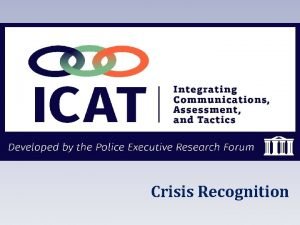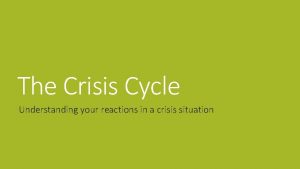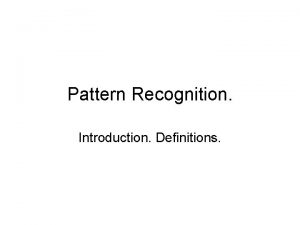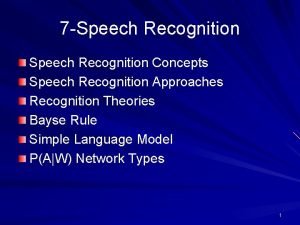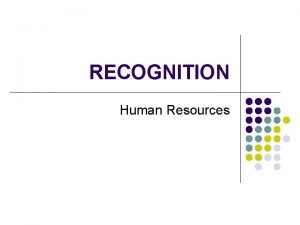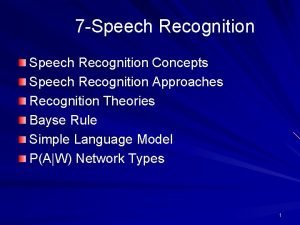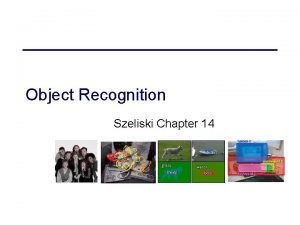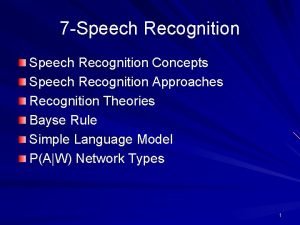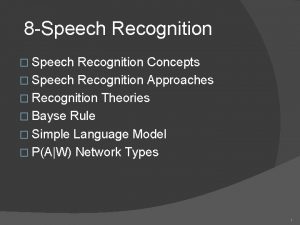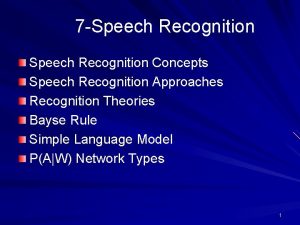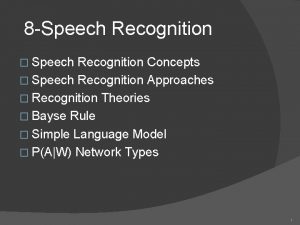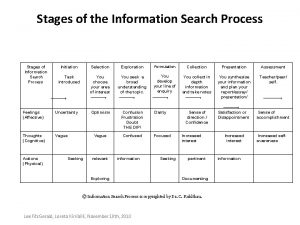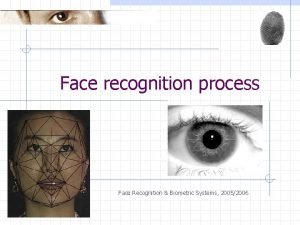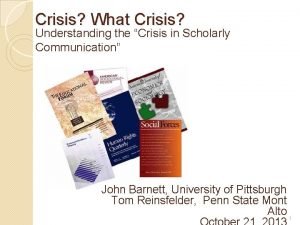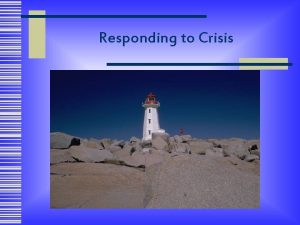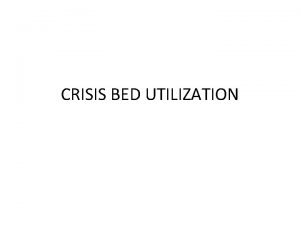The crisis process Stages of Crisis Stages Recognition


























- Slides: 26

The crisis process

Stages of Crisis • Stages: • Recognition: The person realizes that they are not coping well • The person struggles to solve the problem and may ask others for help • Not being able to solve the crisis the person is overwhelmed by emotions including fear, anger, confusion, and inadequacy.

Deal with the feelings • The emotions are blocking the persons ability to think and cope • Help the person look for their own solutions rather them telling them a solution • Needing to have answers provided all of the time lowers the person’s self esteem • Appear calm and in control, and be flexible with your approach. Individualize

Diagnosis and Intervention • Person with Schizophrenia • Impaired thoughts, distorted perceptions • Delusions, hallucinations • Mood presentation may not fit the situation • Withdrawal • Refrain from laughing or making casual responses • DO NOT attempt to correct their misperceptions or convince them that the delusions are wrong or the hallucinations are imaginary • Attempts to use logic makes the person more defensive • Empathize with their feelings • Be calm, patient, and treat the person with respect

Person with Mania • Multiple simultaneous activities • Intrusive, inappropriate, demanding • Elevated mood, emotional lability • Grandiose delusions • Possible hallucinations • Impaired ability to function normally • Calm matter of fact approach • Avoid showing negative reactions to the person’s behavior • Do not argue with the person • Be clear and directive • Do not personalize

Person with Paranoia • Suspicious, anxious, frightened • Believes that others are out to get him • Capable of threatening behavior, typically out of fear • Easily humiliated • Remain confident and maintain eye contact • Try to conceal personal feelings, as the person may sense discomfort and become more frightened • Do not challenge beliefs or question distorted notions

Person with Depression • Persistent sadness, slow body movements • Can become agitated. Thin line between anger and depression • Recurring thoughts of death or suicide possible • Poor concentration, short term memory problems • Feelings of hopelessness • Can have delusions or become psychotic • Instill hope • Point out options available to person • Treat person with empathy, understanding and optimism • Maintain objectivity • Provide activities when available • If possible place them with a cell mate or inmate worker so they are not alone

Person that is Anxious • Fear develops without any logical purpose • May experience fear of dying, of going crazy, and feel panicky • Overwhelming need to feel safe and avoid places they see as unsafe • May experience irrational fear, intrusive anxiety producing thoughts (obsessions), repetitive behaviors (compulsions), or intrusive memories (PTSD) • Reassure person that they are not going crazy • Allow the person an opportunity to express their fear and confusion • Reassure person that they are safe. • Treat person in a calm and matter of fact approach

Active Listening

Active Listening • Active listening is listening not only to the content but also the emotions being communicated to you • It is the emotions behind the content that tell us the most about the person • It is an opportunity to display understanding

Active Listening • Is important because it provides feedback to demonstrate that you are understanding the story and the feelings that are being told to you • You are restating the other person’s position and emotions in a way that the other person hears as non-judgmental and accurate.

Feedback to Demonstrate Understanding

Feedback • Brief Statements of Observations – Generally not questions • Questions are more intrusive • Can create pressure and provoke defensiveness • Can diminish rapport • May prompt denials which can create barriers

Feedback • Brief Statements – Encourage them to go on – Make them feel listened to and respected – Can help diffuse negative feelings and create positive ones – Appears non-judgmental to the person

Active Listening Skills • • Emotional Labeling Paraphrasing Mirroring/Reflecting Summary Open-Ended Questions Minimal Encouragers Effective Phrases “I” Messages

Listening Skills • Emotional Labeling – Stated observation of the emotion heard, “you sound…” “you seem. . ”, “I hear…. ” – Excellent way to begin and very effective – Easy to back off from: – “I didn’t say you were angry, I said that you sound angry. ” – If possible label a lot of feelings it helps someone to feel understood.

Nonjudgmental Attitude is the Key • Feelings are Universal, Experiences are not • It is possible to demonstrate understanding of feelings without having gone through the same experience • You can ask clarifying questions such as “What I think I hear you saying is …. . Is that what you mean? ” • Even if you are wrong the person will know that you are trying

Listening Skills • Paraphrasing – Put the meaning into your own words – Restatement – Example: Inmate: He doesn’t pay attention to what I say and it makes me angry Officer: He doesn’t listen to you

Listening Skills • Mirroring/Reflecting – Brief follow along, the “gist” of the statement, repeating the last few words – Example: Inmate: He doesn’t pay attention to what I say to him and it makes me angry Officer: It makes you angry

Listening Skills • Summary – Periodically covering the main points – HIS STORY + HIS FEELINGS • In your words Example: O. K. what you’ve told me so far is this … and as a result you feel … Do I understand this correctly? ”

Listening Skills • Open Ended Questions or Sentences – “What else? ”, “How? ”, “When? ” – “Tell me more about …” – “I’d like to hear more…” – Benefits: • Conveys your interest in listening • Gives more freedom of response • Limits feelings of interrogation

Listening Skills • Minimal Encouragers – Indicate your presence… “Uh-huh”, “O. K. ” etc. – Best used when the person is talking for an extended period of time or telling a longer story – Best used in combination with another skill such as paraphrasing or mirroring/reflecting

Listening Skills • Effective Pauses – Immediately before or after saying something meaningful – The “Effect” desired is to help focus thought and interaction

Listening Skills • “I” Messages – Used to confront subject about a behavior that is counterproductive, without being accusatory – Examples: “When you yell, I feel frustrated because it stops me from listening to you. ” “I can’t hear you when you yell at me. ”

Phrases that Damage Rapport • “You should” “You shouldn’t” – These are advice giving statements that create feelings of being “put down” • “I understand” – This is a phrase used to silence people – You may not completely understand their experience • “Calm Down” – This may be perceived as an order statement which can provoke intense anger – Instead speak calmly and slowly

Empathy • Identification/Understanding of another’s situation, feelings, and thoughts • It is neither Opposition or Agreement • It is not necessary to actually feel what they feel to provide empathy • Empathy is not Sympathy – Sympathy is an expression of pity or sorrow for the distress of others – Pity and sorrow are not productive here
 Crisis recognition
Crisis recognition Acetylcholine crisis
Acetylcholine crisis Need recognition process
Need recognition process What is the crisis cycle
What is the crisis cycle Hát kết hợp bộ gõ cơ thể
Hát kết hợp bộ gõ cơ thể Frameset trong html5
Frameset trong html5 Bổ thể
Bổ thể Tỉ lệ cơ thể trẻ em
Tỉ lệ cơ thể trẻ em Voi kéo gỗ như thế nào
Voi kéo gỗ như thế nào Glasgow thang điểm
Glasgow thang điểm Hát lên người ơi
Hát lên người ơi Môn thể thao bắt đầu bằng từ đua
Môn thể thao bắt đầu bằng từ đua Thế nào là hệ số cao nhất
Thế nào là hệ số cao nhất Các châu lục và đại dương trên thế giới
Các châu lục và đại dương trên thế giới Cong thức tính động năng
Cong thức tính động năng Trời xanh đây là của chúng ta thể thơ
Trời xanh đây là của chúng ta thể thơ Mật thư anh em như thể tay chân
Mật thư anh em như thể tay chân Làm thế nào để 102-1=99
Làm thế nào để 102-1=99 Phản ứng thế ankan
Phản ứng thế ankan Các châu lục và đại dương trên thế giới
Các châu lục và đại dương trên thế giới Thơ thất ngôn tứ tuyệt đường luật
Thơ thất ngôn tứ tuyệt đường luật Quá trình desamine hóa có thể tạo ra
Quá trình desamine hóa có thể tạo ra Một số thể thơ truyền thống
Một số thể thơ truyền thống Cái miệng bé xinh thế chỉ nói điều hay thôi
Cái miệng bé xinh thế chỉ nói điều hay thôi Vẽ hình chiếu vuông góc của vật thể sau
Vẽ hình chiếu vuông góc của vật thể sau Thế nào là sự mỏi cơ
Thế nào là sự mỏi cơ đặc điểm cơ thể của người tối cổ
đặc điểm cơ thể của người tối cổ
